| PRIOR TO WWII, THE SHINKOLOBWE MINE IN THE BRITISH BELGIAN CONGO CONTAINED 80% OF THE WORLD'S SUPPLY OF URANIUM. BEGINNING IN 1934, THE UNION MINIÈRE BEGAN SHIPPING VAST QUANTITIES OF URANIUM ORE TO NAZI GERMANY. BY 1937, HITLER HAD ENOUGH ORE FOR A NUCLEAR ARSENAL SO THE MINE WAS CLOSED AND FLOODED. IN SEPT. 1944, GENERAL GROVES PAID THE UNION MINIÈRE $37.5 MILLION TO REOPEN THE MINE FOR THE MANHATTAN PROJECT ATOMIC BOMBS!! |
This explosive expose will make all precious histories of the Bomb obsolete . . . or gone with the wind!
 Panoramic view of the Shinkolobwe Panoramic view of the Shinkolobweuranium mine. |
|
 Interior view of the Shinkolobwe Interior view of the Shinkolobweuranium mine. |
Congolese slaves did most of the backbreaking and dangerous work of loading the uranium on trains and ships.
The Congo uranium was the purest in the world . . . but also the deadliest due to radiation. A huge amount of leftovers or tailings remained after the Nazis had taken thousands of tons of ore. No special consideration was given to the thousands of African slaves who loaded the uranium on the trains and ships.
 King Albert I (1875– 1934). King from 1909 to 1934. |
|
 Queen Elizabeth of Belgium (1876–1965). |
An automobile accident or plane crash is a very convenient way to get rid of troublesome or uncooperative people:
The King and Queen spent several weeks in the Middle East and at the end of the tour they flew home. For some reason or other they decided to take a later plane than the one they had originally been scheduled to travel. As they flew over southern Italy the following morning, they saw, scattered far below them in the snow, the wreckage of the plane on which they should have made their flight. (Aronson, Defiant Dynasty: The Coburgs of Belgium, p. 223).
To be heir to the British Belgian throne was as hazardous to your health as sitting on the throne of "Saint Peter."
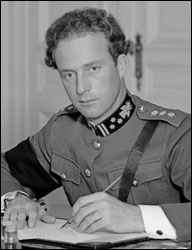 King Leopold III (1901–1935). King from 1934 to 1935. |
|
 Queen Astrid of Belgium (1905–1935). |
Here is a brief quote from a British author about the fatal "car accident" that killed Astrid . . . and her husband:
In the summer of 1935, Queen Astrid was killed while motoring with the King in Switzerland. Returning from a climbing holiday in the Dolomites, they had paused for a few days at their villa at Lake Lucerne. On the morning of August 29, they set out on another climbing expedition in two cars. Leopold driving the first, with his wife at his side and the chauffeur in the rear seat. The Queen diverted her husband's attention by asking him a question about the map she was studying, and in that split second the wheel jumped the kerb. The King lost control. Below the read was a meadow with pear trees, leading down to a lake, one of the trees was close to the kerb and the King's last memory was of the tree looming in front of him. They were both hurled out of the car. Leopold recovered consciousness to find his head cradled in the lap of an unknown woman who helped him to where Astrid was lying. He heard the doctor who was taking her pulse say 'She is dead.' For a moment he was incredulous, then he saw that his wife was wounded as his father had been. Her head was cruelly gashed. He himself had been run over, and he had broken several ribs. Covered with blood, he was assisted by the doctor and he noticed a photographer point a camera at him and an angry bystander knocked it out of the man's hand. (Keyes, Outrageous Fortune, p. 36).
That doctor was on hand to make sure that both of them were dead!
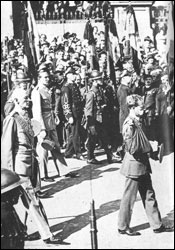
Gustav Oldendorff walking in
the funeral procession!! |
|
 Gustav Oldenforff (d. 1983) was the Leopold III double. |
There is a photograph of King Leopold and Gustav Oldendorff together, but it is locked away in the MI666 archives in London.
Amazingly, rumors were rife that the real Leopold was killed in the "car accident" and that Hitler had replaced him with a doppelgänger:
One ingenious illustrated paper stated, with photographic support, that when Astrid died in 1935 her husband perished with her and had been replaced by a likeness called Gustav Oldendorff. This plan was worked by Hitler himself, and has been applied to other Kings, Generals and statesmen. (Keyes, Outrageous Fortune, p. 388).
That double cross was not the work of Hitler . . . but his cousin Winston Churchill—who was "nuts" about doubles! Staging a "car accident" like that today would have to done in a tunnel because everybody has a camera!
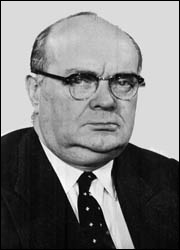
Paul Henri Spaak (1899–1972).
Prime Minister from '38 to '39. |
|
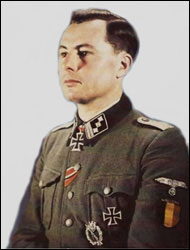
Rexist Léon Degrelle
(1906–1994). |
Degrelle shared the same father . . . but a different mother . . . who has yet to be unmasked!
Nothing made the Belgians more excited than to know that the Führer's half-brother was one of them....That was why they welcomed the Nazis so enthusiastically in May 1940.
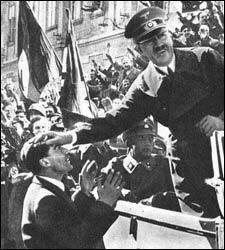 Hitler patting his half-brother on the head in Belgium, May 1940. |
|
 Hitler greeting his half-brother at the "Wolf's Lair" in East Prussia. |
Degrelle fought ferociously on the Eastern Front because he was fighting for the survival of his half-brother's Third Reich!
After the war, Degrelle escaped to Spain, and was given sanctuary by Generalissimo Francisco Franco.... By that time his half-brother was safely ensconced in Argentina.
Attempts to extradite him back to Belgium as a war criminate failed, and he remained an unrepentant Nazi until he went to "Purgatory" in 1994.
The Union Minière du Haut-Katange was an Anglo-Belgian mining company which had a monopoly on the vast mineral wealth of the Congo. From 1934 to 1937, vast amounts of uranium was shipped through the port of Antwerp, and then via train to Nazi Germany.
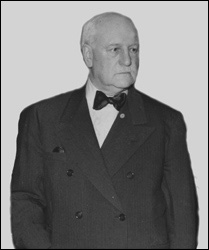 Edgar Sengier (1879–1963). |
|
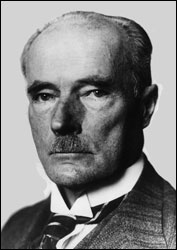 Gustav von Bohlen und Halbach (1870–1950). |
Chemical colossus I.G. Farben also played a major role in developing the Führer's nuclear arsenal.
In August 1939, Dr. Leo Szilard asked Einstein to write a letter to President Roosevelt, warning him about the dangers of Nazi Germany acquiring nuclear weapons.
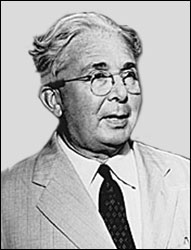
Dr. Leo Szilard
(1898–1964). |
|
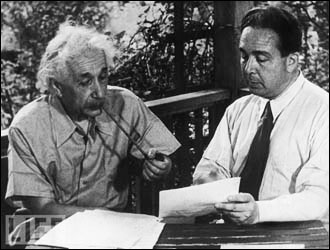 Dr. Szilard explaining nuclear fusion to Einstein, August 1939. |
The uncivil Civil War did not end in April 1865. It was just an armistice or temporary truce. On September 1, 1939, Lord Halifax and Winston Churchill appointed General George C. Marshall as U.S. Army Chief of Staff.
 General George Cunning Marshall (1880–1959). |
|
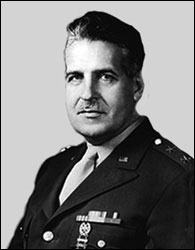
General
Leslie R. "Dick" Groves
(1896–1970). |
By that time Marshall was not sure that Nazi Germany would defeat Russia, so that was the reason why he gave the green light to Groves to develop the Bomb.
Groves was a graduate of the West Point Military Academy. Even though it was a "war" college, recognizing spies and secessionists was not part of the curriculum!
Sengier moved to Manhattan after the invasion of Belgium and sold uranium to Groves
Before Sengier moved to New York he "providentially" arranged for the shipment of 1,200 tons of Shinkolobve uranium to New York:
Towards the end of 1940, 1,200 tons of the stockpiled uranium ore at Shinkolobwe—of approximately 70 per cent uranium oxide—were shipped to New York. A commercial arm of Union Minière was specially set up in New York to arrange for the transport of the ore. This was the African Metals Corporation, also known as Afrimet, which became the sole agent for the sale of Union Minière products in the US. During September and October 1940, the ore was shipped from the Congo and was stored on arrival on Staten Island in New York. (Williams, Spies in the Congo, p. 3).
For about 2 years the uranium was stored in a warehouse and nobody knew what it really was.
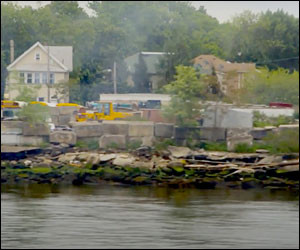 The location on Staten Island where the uranium was stored remains a radioactive residential district. |
|
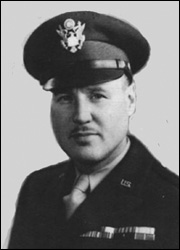 General Kenneth Nichols (1907–2000). |
General Kenneth Nichols was second-in-command of the Manhattan Project:
The ore stored on Staten Island was transferred immediately to the Corps of Engineers. Arrangements were also made to ship to the US the stock of ore remaining in the Congo: 950 further tons of approximately 70 per cent ore; and about 160 tons of 20 per cent ore. To make this possible, Union Minière ran three round-the-clock shifts at Shinkolobwe, where the miners worked in the open pit under searchlights. (Williams, Spies in the Congo, pp-5-6).
General Nicholas was also sent to Shinkolobwe, and he saw the vast amounts of uranium ore that was stockpiled or left over after the mine was closed:
The mine was a huge, open gash about a half-mile square, with terraced sides that went down about 225 feet. It had been closed in 1937, fell into disrepair and became flooded. However, a large stock of mined uranium ore was still piled up there. (Williams, Spies in the Congo, p. 2).
Even a blind man could see that the mine was missing tons of ore. "Military brass" are discouraged (no promotions) from thinking for themselves . . . or asking probing questions!
Groves was "concerned" that Nazis agents in the Congo would steal some of the uranium and ship it to Nazi Germany!
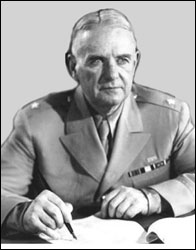
OSS head "Wild Bill" Donovan
(1883–1949). |
|
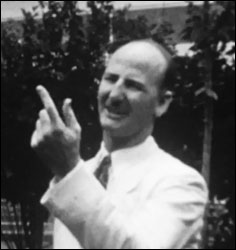
Wilbur "Dock" Hogue
(1909–1952). |
In all about 50 "secret agents" were assigned to that life and death mission!
In November 1942, under the code name Operation Torch, the newly created Pentagon did invade North Africa, but the generals had no plans to seize the strategic Shinkolobwe uranium mine.
General Groves paid Union Minèire $37.5 million to reopen the Sinkolobewe mine!
General Groves could have sent the army to seize the mine, but he preferred to pay Union Minière the fabulous sum of 37.5 million dollars to reopen the mine:
The Belgium agreement became effective in late September, 1944, with an exchange of letters among Belgium Foreign Minister Paul Henri Spaak, Sir John Anderson and Ambassador Winant.
With the signing of the of the purchase agreement with the Union Minière the American trustees were confronted with a serious problem. The contract was for so long a term that appropriated funds could not be counted on from the War Department sources. The Constitution would prevent it.
Our dilemma was solved by arranging for me to be paid by the United States $37,500,000, a sum sufficient to cover that expected obligations. I then deposited that money in a personal account at the U.S. Treasury. From this I made withdrawals as necessary and deposited the money with the Bankers Trust Company of New York. (Groves, Now It Can Be Told, pp. 176-177).
Allowing for inflation, $37.5 million would be about 550 million dollars today. A fabulous sum to speed up the Nazi nuclear program.
General Groves couldn't care less about the Constitution. If he was living during the 19th century he would have been a Confederate general fighing against the New Jerusalem.
Uranium for the Hiroshima and Nagasaki bombs came from the Congo!!
Incredibly, the uranium for the Nagasaki and Hiroshima bombs came from the Shinkolobwe uranium mine in Katanga.
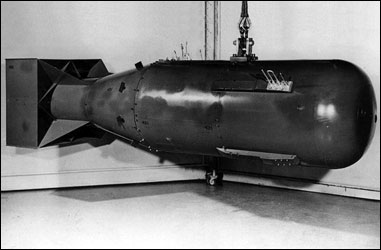 The uranium bomb was called "Little Boy." |
|
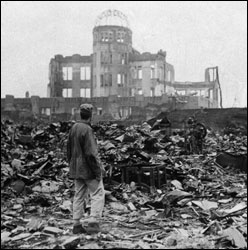 Devastation of Hiroshima after Devastation of Hiroshima afterthe bomb was dropped! |
The scientists discovered that plutonium would not work with the uranium type bomb because it required a highly complicated trigger mechanism. General Groves built a huge plutonium processing plant in Hanford, Washington state.
 The implosion type nuclear bomb was called "Fat Man." |
|
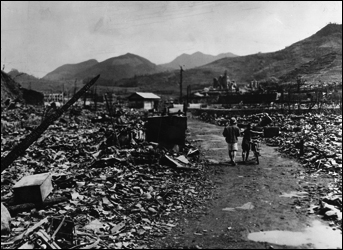 Destruction of Nagasaki from the Destruction of Nagasaki from the plutonium bomb. |
The bomb was more powerful than the Hiroshima bomb, but casualties were fewer, because the city was protected by surrounding hills.
General Groves awarded Edgar Sengier a Presidential Medal of Merit!!
"Dinosaur" Henry L. Stimson, along with General George C. Marshall, conspired to prolong the war by denying gasoline to General Patton. That was done in order to give the Nazis more time to develop their "wonder weapon."
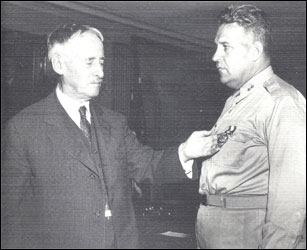 The dinosaur awarding a medal to General Groves, Sept. 4, 1945. |
|
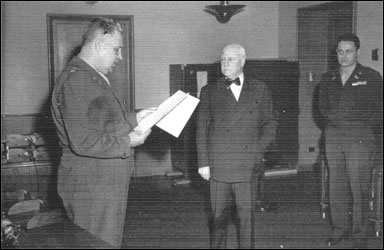 In 1946, Sengier was awarded a medal by General Groves for supplying the Nazis with uranium! |
Groves went on to enjoy a long and prosperous career after the war. Only the Day of Judgment will reveal the vital role he played in the development of the Nazi atomic bomb.
Russia captured most of the Nazi nuclear scientists and seized the Shinkolobwe uranium!!
Defeating the Third Reich cost the Russians about 10 million casualties. Just the threat of sending the Marines to Europe would have prevented the war in the first place.
|
|
We don't know if the Nazis used nuclear weapons on the Eastern Front, but if they nuked Moscow they would have killed the Stalin double!!
General Groves erroneously estimated that it would be 1954, or later, before the Soviets acquired an atomic bomb:
But there was anecdotal evidence, at the very least, to suggest that the Soviets were not so very far behind the Americans. According to an entry in October 1945 in the diary of Hugh Dalton, the British Chancellor of the Exchequer, the Foreign Secretary Ernest Bevin told him that at a big reception at the Soviet Embassy, he heard Vyacheslav Molotov, the Soviet Minister of Foreign Affairs, claim that the Soviets already had the bomb: he was in the outer hall with Molotov, Gusev [F. T. Gusev, Soviet Ambassador to Britain] and Madame G. Molotov was ‘drinking all his toasts as usual’ and, Bevin thought, had by now drunk rather much, even for him. Molotov then said, ‘Here’s to the Atom Bomb!’ And then he added, ‘We’ve got it.’ Gusev, at this point,’ Bevin told Dalton, ‘put his hand on Molotov’s shoulder and hurried him away.’ (Williams, Spies in the Congo, p. 232).
To the great dismay of General Groves, the Russians did test a plutonium bomb on August 29, 1949.
It was the brave Russian soldiers, and General's Patton's Third Army, that prevented the Nazis from snatching victory from the jaws of defeat by deploying their nuclear arsenal!
Their third failure was not unprecedented.... In September 1914, and again in June 1918, the Huns were just 30 miles from Paris, yet they failed both times because Pope Benedict XV was "praying" for them . . . and JEHOVAH of Hosts was fighting against them!
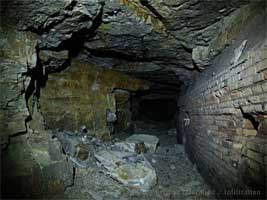
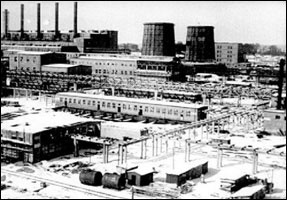 Auschwitz isotope separation plant.
Auschwitz isotope separation plant.